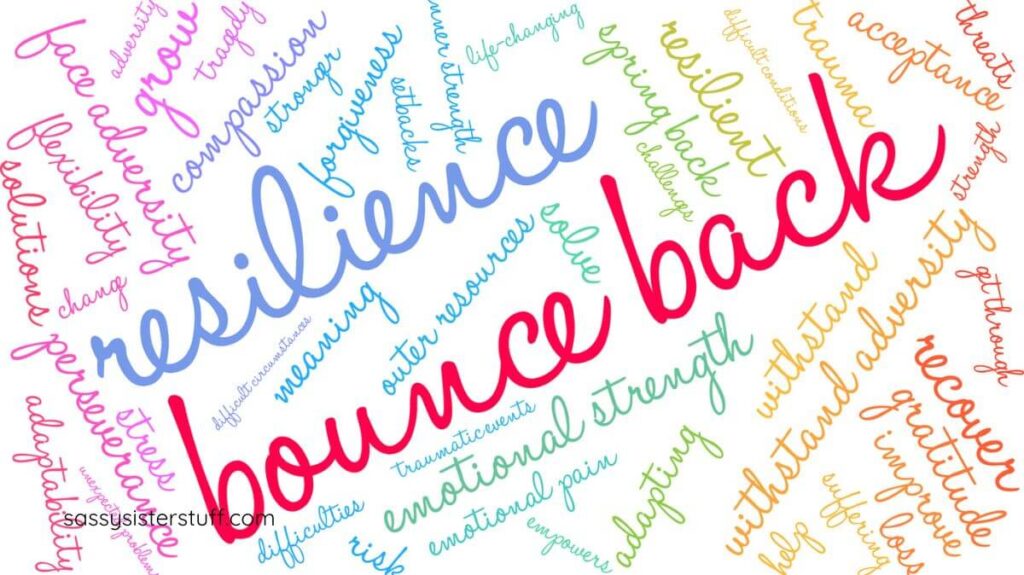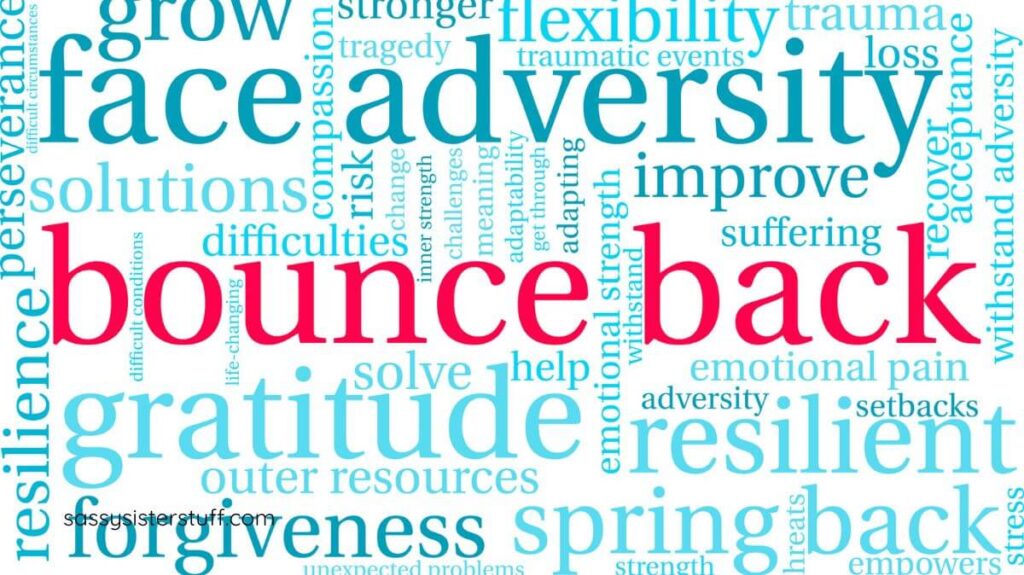15 Empowering Ways to Build Resilience in Midlife and Beyond
Building inner strength and resilience in midlife and beyond is essential to your well-being.
Think of all the changes you may face as you grow through these years — menopause, gray and thinning hair, retirement, vision and hearing changes, sleep disturbance, weight gain or loss, grief — and so many more.
You’ll need to have inner strength and resilience to feel successful in your journey, right?

According to the Merriam-Webster Dictionary, resilience is the “ability to recover from or adjust easily to misfortune or change.”
Imagine if you did not possess the character trait of resilience. How would you manage through these years? This is why you need to know ways to build resilience in midlife and beyond.
Resilience is a combination of inner strength and outer resources. This means you believe in yourself and your capacity to overcome adversity.
Plus, you know how to find the external help you need when it’s difficult to handle a heartbreak you never saw coming.
Inner strength and resilience go hand-in-hand and directly impact your life. That’s why it’s important to grow and nurture these skills, especially now. So, let’s dive in and learn 15 empowering ways to build resilience in midlife and beyond!

#1 Embrace Change as a Growth Opportunity
Picture midlife as less of a storm and more like a plot twist in your favorite novel — unexpected but packed with possibility.
Instead of resisting changes, welcome them as new chapters brimming with lessons to unlock. When you flip your perspective to see change as a bridge instead of a barrier, resilience becomes less about brute strength and more about clever navigation.
- Shift Your Mindset: Training your brain to spot opportunities hidden within challenges rewires your response to stress, making you more adaptable over time. It’s like swapping a flat tire with a fresh set rather than dwelling on the inconvenience.
- Accept Uncertainty: Midlife can feel like walking in the fog but accepting that you can’t control everything frees you to focus on what you can influence, creating calm in chaos.
- Learn from Setbacks: Each failure is a backstage pass to wisdom that textbooks don’t teach. Embrace mistakes as quirky mentors rather than embarrassing hurdles.
- Visualize Positive Outcomes: Imagining success — or at least survival — with humor lightens the emotional load, easing the process of bouncing back.
- Adopt a Growth Mindset: Believing skills and resilience can develop over time transforms midlife from a “use it or lose it” dilemma into an ongoing adventure of self-improvement.
When you shift how you see change, the midlife stretch can feel like less of a battle and more of a dance. Resilience blooms when you accept growth’s unpredictable rhythm and sway with it. Think of it as midlife’s gift: a front-row seat to your own unfolding story.
#2 Cultivate a Strong Social Network
Ever noticed how bouncing back feels easier with friends cheering you on? That’s no coincidence.
Midlife resilience leans heavily on the quality of your social tribe. Building genuine connections is like having a safety net woven from shared laughter, advice, and the occasional unapologetic rant session.
- Reach Out Regularly: Consistent check-ins nurture bonds and make it easier to share both joys and struggles without hesitation.
- Diversify Your Circle: Friends from different walks of life bring fresh perspectives and unexpected solutions when times get tough.
- Make Time for Face-to-Face: Digital connections are great, but in-person interactions amplify emotional support with richer communication cues.
- Offer Support Too: Relationships deepen when help flows both ways, turning connections into sturdy pillars during life’s storms.
- Join Interest Groups or Clubs: Shared activities build camaraderie naturally, turning acquaintances into lifelong allies.
Surrounding yourself with a supportive crew isn’t about quantity but quality and reciprocity. When friends become resilience partners, midlife challenges diminish because you’re no longer facing them solo.

#3 Prioritize Physical Wellness
Think of your body as the ultimate midlife ally. A well-tuned engine handles bumps on the road better, so taking care of physical health isn’t vanity — it’s survival.
Consistent exercise, balanced nutrition, and sleep rituals create a foundation that keeps you energized and clear-headed when life throws curveballs.
- Regular Exercise: Activities like walking, yoga, or swimming boost mood-enhancing endorphins and help fend off chronic stress effects.
- Balanced Diet: Eating whole foods rich in vitamins and minerals fuels both brain and body, supporting sharper focus and better endurance.
- Quality Sleep: Prioritizing 7-9 hours consistently allows your body to repair and your mind to consolidate memories and emotions effectively.
- Hydration: Drinking enough water prevents fatigue and keeps energy levels steady throughout the day.
- Routine Health Checks: Regular screenings catch potential issues early, allowing for proactive management rather than reactive crisis control.
Focusing on your physical wellness is like charging your phone before a long day — adequate power, everything slows down, including your ability to cope. It’s less about perfection and more about respect for the vessel that carries you through midlife’s twists and turns.
#4 Develop Mindfulness and Meditation Practices
Ever feel like your mind is a buzzing beehive you just can’t turn off? Mindfulness and meditation work like a mental “pause button,” helping you regain composure amid midlife chaos.
These practices don’t require hours or fancy retreats — just a few focused minutes can enrich your mental clarity and emotional balance.
- Start Small: Even five minutes of mindful breathing daily can reduce stress and recalibrate your focus efficiently.
- Use Guided Resources: Apps and videos make meditation accessible and keep you on track with structured practices.
- Incorporate Mindfulness into Daily Activities: Paying full attention to chores or walks anchors you in the present, reducing overwhelm.
- Practice Non-Judgment: Observe thoughts and feelings without labeling them good or bad, which fosters emotional resilience.
- Consistency Over Length: Regular short sessions build stronger habits and benefits than infrequent long ones.
Mindfulness is like tuning your inner radio to clear static, enabling you to hear life’s messages better. In midlife, where mental noise often ramps up, a calm mind lets you respond thoughtfully rather than react impulsively.

#5 Set Realistic, Flexible Goals
Imagine midlife goals as sandcastles on a shoreline — beautiful but subject to shifting tides.
Setting goals that are achievable and adaptable reduces frustration when life demands detours. This flexibility turns planning into a playful strategy rather than a rigid script you must follow.
- Break Big Goals into Smaller Steps: Tackling manageable chunks makes progress feel steady and attainable rather than overwhelming.
- Adjust Goals as Needed: Life throws curveballs, so revisiting and revising your plans keeps them relevant and motivating.
- Celebrate Small Wins: Recognizing little victories fuels momentum and confidence, essential ingredients of resilience.
- Align Goals with Values: Goals rooted in what truly matters for you increase commitment and satisfaction.
- Track Progress Visually: Using journals or apps to monitor achievements reinforces effort and highlights patterns for improvement.
Flexibility in goal setting is your midlife superpower—it minimizes stress around perfection and maximizes fulfillment from progress. Think of it as building with Lego bricks rather than cement, allowing creativity and adjustment.
#6 Reflect on Past Successes and Challenges
Midlife is like having a personal highlight reel combined with those blooper moments.
Reflecting on what you’ve conquered and the tough spots you’ve survived reminds you that resilience runs in your veins, even if it sometimes hides behind doubt. This retrospective insight feeds strength for navigating what’s next.
- Create a Timeline: Map key life events to see patterns of persistence, growth, and lessons learned over the years.
- Journal Regularly: Writing about past challenges and wins clarifies how you overcame obstacles and what strategies worked.
- Reframe Negative Moments: View setbacks as springboards rather than stop signs, boosting your confidence to face future trials.
- Share Stories with Trusted Friends: Talking through your history builds connection and often reveals new insights you hadn’t noticed.
- Identify Strength Themes: Spot recurring qualities like courage or creativity that have been your anchors during tough times.
Making peace with your personal history equips you with a resilience toolkit assembled over the years. When you recognize your resourcefulness in past storms, you build trust in your ability to weather midlife’s unpredictable weather.

#7 Build Emotional Agility
Imagine your emotions as a colorful spectrum rather than just black and white. Emotional agility means accepting all feelings — even the uncomfortable ones — and responding to them with curiosity instead of resistance. It’s like becoming a skilled surfer who rides waves instead of being thrown off by them.
- Label Your Emotions: Naming feelings precisely (like “frustrated” instead of just “bad”) helps process them more effectively.
- Practice Self-Compassion: Treat yourself with the kindness you’d offer a friend, especially when emotions run high or mistakes occur.
- Detach from Negative Thoughts: Recognize that feelings aren’t facts but signals to be interpreted, allowing greater perspective.
- Develop Problem-Solving Skills: Channel emotional energy into practical steps rather than ruminating or avoiding.
- Seek Feedback: Trusted others can provide perspective that helps balance emotional reactions with reality.
Emotional agility smooths the bumps of midlife by turning feelings into guides rather than enemies. It’s a skill that transforms emotional storms into seasons, each with its own rhythm and value.
#8 Nurture Creativity and Curiosity
Midlife is a fantastic time to let your inner explorer roam free. Engaging your creativity and curiosity keeps your brain buzzing and your spirit buoyant, offering fresh angles to tackle life’s puzzles.
Think of it as midlife’s secret sauce — adding unexpected flavor to everyday moments.
- Try New Activities: Whether painting, cooking, or coding, novel pursuits stimulate brain growth and joy.
- Ask Questions Often: Cultivating curiosity helps you see familiar situations with fresh eyes and reduces rigidity.
- Keep a Curiosity Journal: Write down ideas or wonders that pop up spontaneously; these can lead to exciting discoveries.
- Collaborate with Others: Shared creative endeavors spark inspiration and new perspectives.
- Allow Playfulness: Give yourself permission to experiment without pressure to succeed, reigniting a childlike delight in learning.
Creativity and curiosity are more than hobbies in midlife; they’re tools that expand resilience by fostering flexibility and fresh thinking. A curious mind keeps you receptive and engaged, making challenges feel like puzzles instead of problems.

#9 Establish Healthy Boundaries
Think of boundaries like your personal fence — essential for keeping your energy safe and relationships respectful.
Midlife often brings competing demands, so clearly setting limits protects your peace and prevents burnout. It’s not about shutting people out but choosing how and when to open doors.
- Identify Your Limits: Knowing what drains or energizes you clarifies when and where to say no.
- Communicate Clearly: Honest and calm conversations about your needs reduce misunderstandings and resentment.
- Practice Saying No: No is a complete sentence, and using it kindly preserves your resources without guilt.
- Guard Your Time: Scheduling downtime and sticking to it honors your well-being as much as work or family demands.
- Recognize Toxic Relationships: Limiting contact with draining or negative individuals frees up space for support and growth.
Healthy boundaries are essential resilience-building bricks, preventing emotional exhaustion and fostering respect in all your connections. They’re your way of saying, “I’m valuable — and here’s how I protect that.”
#10 Practice Gratitude Daily
Gratitude is like midlife’s secret sunshine — it doesn’t erase clouds but makes them easier to bear. A daily habit of noticing what’s good in your life shifts focus away from what’s missing or broken. It’s a simple practice that cultivates optimism and emotional resilience.
- Keep a Gratitude Journal: Writing three things you’re thankful for each day rewires your brain to notice positives more naturally.
- Express Thanks to Others: Telling friends or family you appreciate them strengthens bonds and uplifts both sides.
- Focus on Small Joys: Savor moments like morning coffee aroma or bird songs, building a rich tapestry of gratitude.
- Use Visual Reminders: Photos or notes that trigger grateful memories help sustain this mindset throughout the day.
- Combine Gratitude with Mindfulness: Pairing these practices deepens the emotional impact, anchoring you in present contentment.
Gratitude turns the lens outward to acknowledge life’s gifts instead of complaints. For midlife resilience, this daily practice builds a cushion of appreciation that softens stress and fuels hope.

#11 Learn New Skills or Hobbies
Picking up new skills in midlife is like adding shiny tools to your resilience toolbox. Whether it’s learning a language, cooking, or tech skills, fresh challenges keep your brain nimble and confidence high. Plus, the joy of mastering something new helps offset midlife ruts.
- Choose Enjoyable Activities: Passion fuels persistence, so pick hobbies that genuinely excite or intrigue you.
- Set Small Learning Goals: Breaking skills into bite-sized pieces reduces overwhelm and builds momentum.
- Join Classes or Workshops: These provide structure, social contact, and expert guidance to accelerate learning.
- Embrace Beginner’s Mind: Expect mistakes as part of the process, which keeps frustration in check.
- Celebrate Milestones: Acknowledging progress maintains motivation and reinforces resilience habits.
Engaging with new skills literally rewires your brain for growth, refreshes your sense of self, and empowers you to face midlife changes with curiosity. Learning becomes an act of reclaiming agency and joy.
#12 Seek Professional Support When Needed
Sometimes midlife gets too tangled to untie solo, and that’s perfectly okay. Reaching out to therapists, coaches, or counselors is a savvy move — like calling in expert guides for tricky terrain.
Professional support offers tools, perspective, and validation that boost your ability to navigate tough emotional or life transitions.
- Normalize Asking for Help: Seeking support is a strength, not a weakness, acknowledging that expert guidance sharpens resilience.
- Find Specialties Fit for You: There are professionals for every issue — from grief to career pivots — so choose accordingly.
- Try Different Formats: Options include in-person, teletherapy, group sessions, or workshops — pick what feels right and accessible.
- Prepare Questions or Goals: Clear intentions maximize the benefit of your sessions, keeping focus on your growth.
- Combine Support with Self-Care: Therapy works best alongside habits like exercise and mindfulness, creating a holistic resilience plan.
Getting professional help often speeds up your bounce-back time and deepens your self-awareness. It’s like investing in a personal trainer but for your emotional and psychological muscles.

#13 Maintain a Sense of Humor
If the second half of your life feels like a quirky sitcom, laughter is your secret weapon. Humor softens hard moments, creating emotional distance from stress and reminding you that even chaos can be absurdly entertaining.
Keeping a lighthearted perspective doesn’t deny problems but balances their weight.
- Look for the Funny Side: Finding humor in daily mishaps helps lower tension and increase resilience by shifting perspective.
- Share Laughs with Others: Jokes and playful banter build connection and diffuse conflicts before they escalate.
- Watch or Read Humorous Content: Comedies or witty books provide an easy way to recharge your mental batteries.
- Don’t Take Yourself Too Seriously: Celebrating imperfections with self-deprecation enhances humility and stress relief.
- Use Humor to Reframe Stressful Situations: A silly analogy or unexpected punchline can turn daunting problems into manageable puzzles.
Infusing humor into midlife challenges transforms heaviness into lightness, making resilience feel more like a dance. It’s a reminder that while life isn’t always neat, it’s often amusing if you let it be.
#14 Volunteer or Give Back to the Community
Helping others is like a boomerang for resilience—you throw out kindness and it comes back with emotional rewards.
Volunteering connects you to something bigger than yourself, fostering purpose and perspective in midlife. Plus, the stories and friendships it creates are resilience gold.
- Choose Causes You Care About: Genuine passion makes volunteering feel rewarding rather than obligatory, fueling sustained engagement.
- Commit to Manageable Time Frames: Even small, regular contributions prevent burnout and keep involvement sustainable.
- Engage Socially: Many volunteer activities foster deep friendships and mutual support, enhancing your social network.
- Focus on Impact: Seeing tangible results of your efforts boosts motivation and nurtures hope.
- Learn New Skills: Volunteering often offers opportunities to develop leadership, communication, and organizational skills.
Giving back isn’t just altruism—it cultivates resilience by enriching your emotional ecosystem. It reminds you that your energy matters and can spark ripple effects far beyond your own circle.

#15 Keep a Resilience Journal
Imagine a place where you can safely dump worries, celebrate wins, and track your emotional weather. A resilience journal is that private refuge, offering clarity and self-encouragement during midlife’s rollercoaster.
Over time, it reveals patterns that help you anticipate challenges and appreciate growth.
- Write Freely and Honestly: There’s no special format — just express your thoughts, feelings, and reactions without censoring yourself.
- Include Positive Affirmations: Remind yourself of your strengths and past triumphs to build confidence on tough days.
- Track Progress and Setbacks: Noticing what helps or hinders resilience sharpens your coping toolkit.
- Incorporate Quotes or Inspirations: Adding meaningful words or images boosts motivation and focus.
- Review Regularly: Reflecting on entries uncovers growth areas and reinforces your resilience journey.
Keeping a resilience journal turns midlife reflections into actionable insight. It’s a personal coach and cheerleader rolled into one, helping you navigate transitions with greater ease and awareness.

Final Thoughts: Ways to Build Resilience in Midlife
These 15 ways to build resilience in midlife and beyond are comprehensive and essential. They are easy to build directly into your life as part of a healthy lifestyle that supports your overall well-being.
Now that you are in middle-age or beyond, you need these skills more than ever. Yet sometimes as a woman you get tired and lose sight of your sense of self and internal energy. Don’t let that happen.
Focus on these 15 self-care practices that will help you maintain your inner strength and resilience at this time. That way when adversity comes your way (and it WILL!), you’ll be ready for it!
Related Articles You’ll Love:
You’re on a mission to make the most of midlife and beyond — building resilience, finding purpose, and growing stronger from the inside out. These related articles will support and inspire you as you continue your beautiful journey of personal growth and self-discovery.
- 5 Strategies to Help You Take Ownership Of Your Life
- Embracing the Power of Lifelong Learning as You Age
- Personal Growth for Women over 50: Unleash Your Potential
- 17 Valuable Tips for Finding Purpose in Life after 50
Love to ALL! ~ Susan







